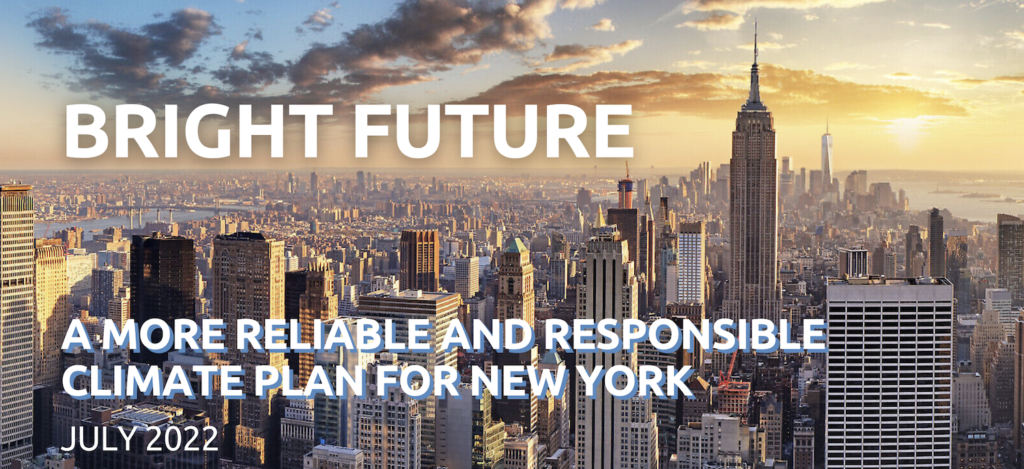
 | 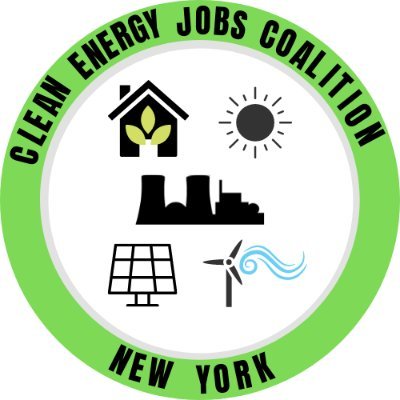 | 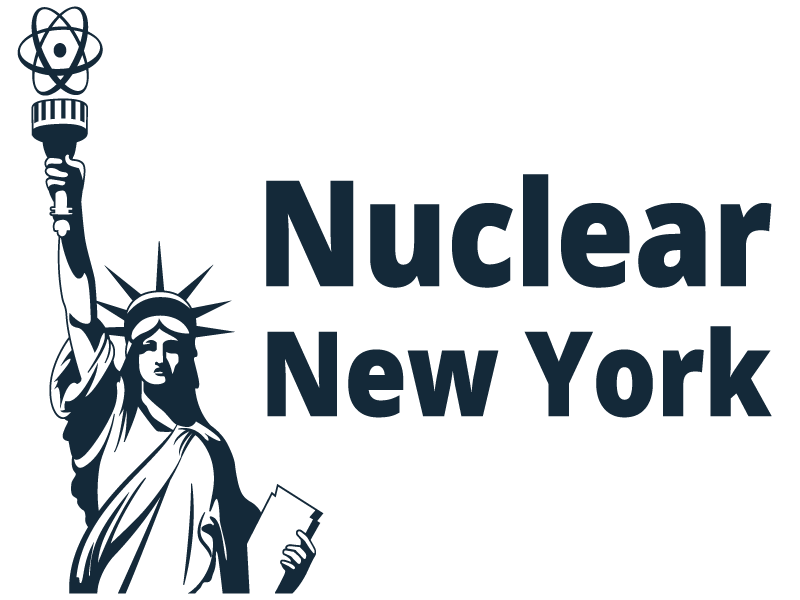 |
Foreword by Prof. Joshua S. Goldstein, Professor Emeritus of International Relations, American University
and
Dr. James E. Hansen, Climate Scientist, Earth Institute, Columbia University
Key Points
- Making nuclear energy the foundation of New York’s carbon-free grid would ensure reliable, affordable, and sustainable decarbonization.
- Nuclear provides well-paying generational jobs for skilled tradesfolk to enable vibrant and healthy host communities enriched by steady tax revenues.
- A Made-In-America nuclear program offers a strong solution to the energy security challenges facing the state and country, including our reliance on foreign supply chains and intermittent energy technologies.
- Nuclear is the electricity source with lowest lifecycle greenhouse gas emissions and smallest land footprint. Nuclear is also among the least impactful with respect to mining, materials, and toxicity to humans.
- Expansion of nuclear energy will enable a responsible build-out of solar and wind facilities, conserving nature and productive farmland from energy sprawl. Even a meager build-out of 4 gigawatts would save over a billion dollars for New Yorkers per NYSERDA.
- Extending the operating licenses of New York’s currently operating nuclear plants from 60 years to 80 years would save $9 billion in decarbonization costs per NYSERDA.
- The spent fuel from today’s reactors (i.e. the “waste”) can be recycled to power the next generation of carbon-free nuclear plants.
- The safety record of nuclear in America is unmatched by any other energy source.
Key Recommendations
- Extend the Zero Emission Credits program to ensure timely investment in license renewals and capacity upgrades of upstate nuclear power plants.
- Work with the U.S. Nuclear Regulatory Commission, U.S. Department of Energy, U.S. Environmental Protection Agency, and other necessary state and federal agencies to authorize and expedite the siting of new nuclear technology without delay.
Introduction
New York’s Climate Leadership and Community Protection Act (CLCPA) is one of the most ambitious pieces of climate legislation in the world. The act requires New York to have 100% carbon-free electricity by 2040 and aims for economy-wide decarbonization by 2050. The scale of this challenge is staggering: in 2021, 49% of New York’s electricity generation was from carbon-free sources, largely due to nuclear (24% of total) and hydro (22% of total).
In December 2021, New York’s Climate Action Council published a Draft Scoping Plan (CAC Plan) as the foundation for extensive collaboration. We agree with the CAC Plan that to meet our climate goals will require “comprehensive vision and integrated approach to build new programs while significantly expanding existing efforts.” This Brief, titled ‘Bright Future,’ presents how New York can achieve a clean, resilient, and affordable electricity system for all New Yorkers without compromising New York’s workers, communities, or natural landscapes. A just transition must make a low-carbon economy a benefit, not a burden, to New Yorkers.
The CAC Plan anticipates electricity demand to double by 2050, largely due to the electrification of the transportation and building heating sectors. The New York Independent System Operator (NYISO), the state’s non-profit grid operator, asserts that “The path to a greener grid must remain a reliable one.”
They warn reliability margins are shrinking and raise concerns about retiring generators needed for reliability amidst delays in constructing new supply. NYISO emphasizes that, “higher than expected demand and extreme weather could threaten reliability and resilience in the future.” For a successful transition “we must build and interconnect technologies that fill in reliability gaps and mimic the reliability attributes of our existing fleet of generation.”
While New York is poised to embrace utility scale geothermal networks for heating and cooling, as well as innovations in hydrogen for clean fuels, the state will need abundant, carbon-free power to decarbonize. This brief will first present the case for making nuclear power the backbone of New York’s decarbonization framework.
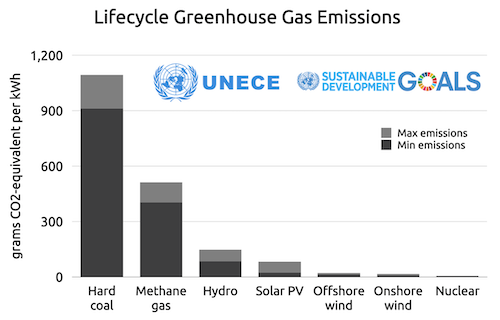 | 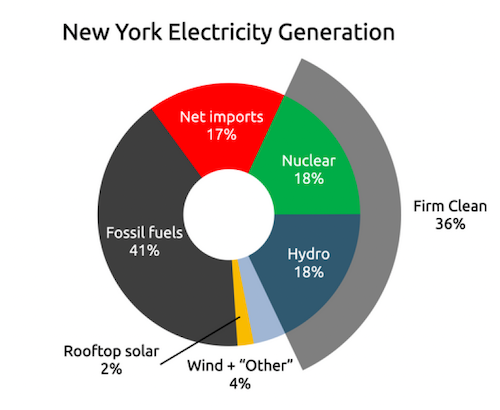 |
An abundant, affordable, reliable, and resilient electric grid is the backbone of every prosperous modern society. The energy transition will ultimately fail if it causes energy to become scarcer or more expensive. Sacrificing reliability or affordability of low-carbon energy are regressive choices that disproportionately hurt the most vulnerable and have the potential to derail decarbonization efforts.
Like fossil fuels, nuclear plants can reliably deliver power as-needed, regardless of time of day, season, or weather. Unlike fossil fuels, nuclear can do so without combustion; hence no carbon emissions or harmful air pollutants. In fact, a comprehensive analysis conducted by the United Nations found nuclear also has the lowest lifecycle greenhouse gas emissions of any type of electricity generation, solar and wind included.
Despite all four of the Intergovernmental Panel on Climate Change (IPCC) illustrative pathways that limit global warming to 1.5 C calling for 2050 nuclear generation to be 2x to 6x the 2010 level, the CAC Plan has nuclear power playing a smaller role in New York’s future. Nuclear energy is available, scalable, and deployable today. By expanding the suite of carbon-free technologies beyond wind and solar, New York can lead the transformational change for effective climate mitigation.
Bright Future
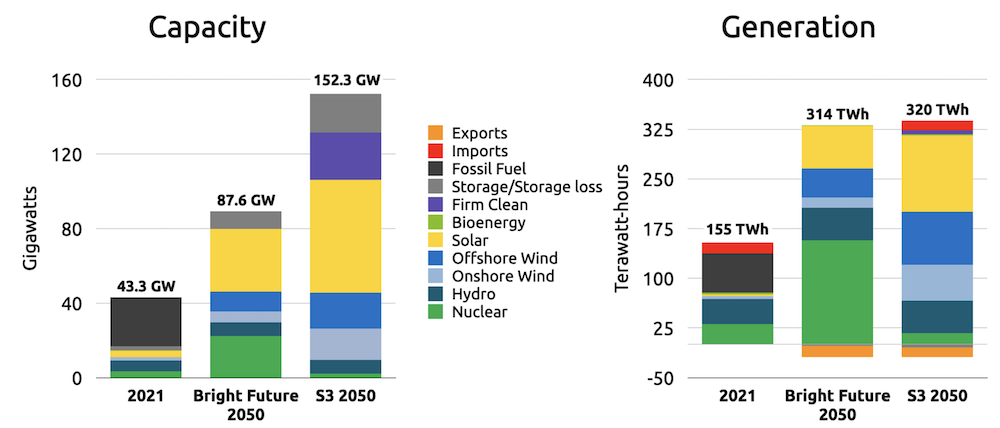
Benefits of Bright Future
Equitable Access to High Quality, Family-Sustaining Jobs for Vibrant and Healthy Communities
For a clean energy transition to be successful, it must be advantageous for the workers responsible for delivering it. That means quality of work and wages of current fossil fuel workers must be maintained or improved upon. New jobs should be able to build and sustain communities, with equal opportunities for all New Yorkers in diverse and desirable careers. The electricians, pipe fitters, millwrights, and boilermakers who keep our lights on and our homes comfortable have earned the right to a prosperous life. Our ability to create a just transition is inseparable from technology choice, with each scalable power generation option having a better or worse potential to create high-quality, community-building, uplifting jobs that power domestic supply chains.

U.S. Energy and Employment Jobs Report, Department of Energy
Nuclear provides well-paying jobs that enable vibrant, healthy, and prosperous host communities. New York’s three operating nuclear energy plants support 25,000 jobs, contribute over $3 billion to New York’s economy and generate $144 million state and local taxes annually. Nuclear energy is produced with inexpensive fuel and high-skilled labor, the largest component of its costs. Nuclear plants are bustling facilities with large parking lots and abundant year-round work for skilled tradespeople, nuclear operators, STEM professionals, firefighters, healthcare professionals, and more. Multi-generational employment at nuclear power plants ensures steady tax revenues enriching local communities.
Nuclear is the perfect community energy source from the perspectives of communities that either have to find new industries with tax revenue and employment or face decline followed by blight. According to the International Monetary Fund, nuclear energy has the largest economic multiplier effect of any clean energy technology. Nearly all the money spent on nuclear energy stays in New York and the U.S. Investing in nuclear is the ultimate economic stimulus.
Protection and Restoration of New York’s Natural and Working Lands

It is important that, in addressing climate change by reducing emissions, other aspects of environmental protection such as biodiversity and land conservation are considered. The aforementioned United Nations study also confirmed that nuclear energy has the smallest life-cycle land footprint of any energy source. It is also among the least impactful with respect to mining, materials, and toxicity. Compared to nuclear and conventional fossil fuels, solar and wind have very low energy densities. Because of these low energy densities, large collection areas are necessary to meet demand (and that still does not solve for seasons, wind droughts, etc.).
Expanding land area used for electricity generation harms the goal of conserving forests and wildlife, while taking away potential carbon sinks that reduce atmospheric greenhouse gas concentration.
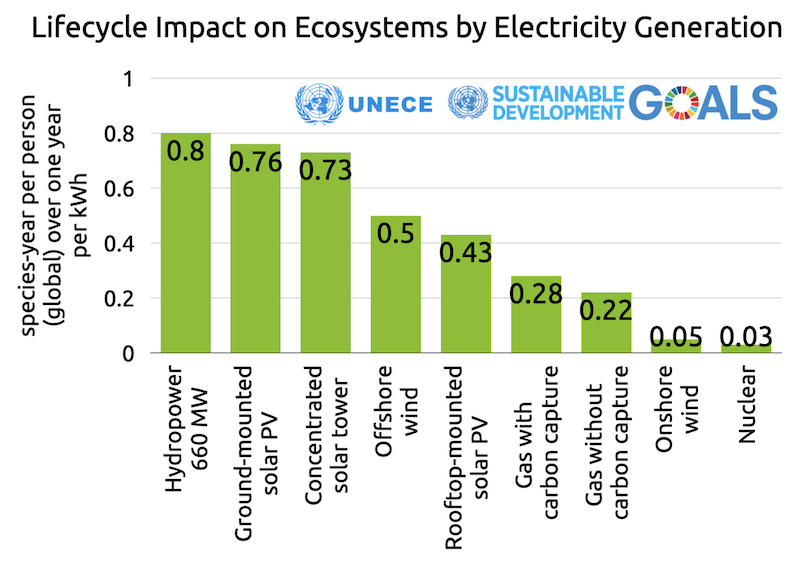
Without preserving existing nuclear or deploying advanced reactors, solar and wind generation would require the industrial development of far more land than necessary for decarbonization. The three nuclear power plants in upstate New York produce enough carbon-free electricity for 3.8 million homes on just 2,050 acres of land. And all of the spent fuel created over the 52 years of its operation could fit on less than half of a Walmart parking lot. Just replacing the energy output of New York’s upstate nuclear plants would require covering between 100 and 200 square miles of land with solar panel projects.
Redevelopment of Industrial Communities & Decarbonization Technologies
CAC Plan’s Appendix C warns “New policies that increase the cost of energy, reduce the reliability of energy, or increase the cost of emitting GHGs could cause businesses to shift their production outside of New York, or avoid the State altogether and instead invest in out-of-state locations with lower energy and/or GHG emission costs.”
Jurisdictions that have invested heavily in wind and solar while ignoring or shutting down nuclear capacity have experienced significant increases in the cost of electricity. For example, Germany’s electricity is twice as expensive as France’s, despite French electricity being 6 times as clean (France gets 70% of its electricity from nuclear power; Germany got 29% of its electricity from coal and lignite). Here in the U.S., California has seen its retail electricity prices climb 80% higher than the average of the remaining contiguous states.[10] By pursuing a similar decarbonization strategy, the CAC Plan would make energy more scarce and expensive, chasing away industry and leading to energy poverty.
By expanding New York’s existing nuclear power generation, Bright Future paves the path to abundant, affordable, reliable and clean energy to support all industries. While much of the country has seen electricity prices climb as a result of the global energy crisis, Illinois consumers are actually seeing their electric bills decline. This is because the state secured the operation of its nuclear power plants as a hedge against high fossil fuel prices. Nothing attracts future-facing industries like a reliable source of affordable energy.
Development of Robust In-State Low-Carbon Energy and Manufacturing Supply Chains
The coronavirus pandemic has revealed the fragility of America’s supply chains and the consequences of relying on other nation’s for our most important goods and services. As such, Climate Action Council’s Just Transition Working Group wants to bolster industry and retention of sustainable economic development.
Differences in materials, labor, and manufacturing requirements between nuclear, wind, and solar create dramatically different supply chains. With such large investments needed to transform the energy sector, we must aim to capture as much of that investment as possible in domestic supply chains, and ensure that these new power sources create permanent, high-skills, well-paying jobs with opportunities for everyone.
By relying heavily on solar and wind, the CAC Plan would be extremely dependent on offshore supply chains. Powered by low-cost coal, China is the top manufacturer of solar panels and wind turbines in the world. Eighty percent of global polysilicon and ninety-eight percent of the world’s silicon wafers and ingots come from China. Seven out of the top ten wind turbine manufacturers are Chinese, and many European wind developers are moving manufacturing to China for cheaper glass fiber, blades, and steel.
Much of the nuclear supply chain is already domestic. The scale of nuclear projects and the high-skilled labor and operational requirements make it extremely difficult to offshore much of this industry. Nuclear was invented in America and had a completely independent supply chain at the advent of the industry. With proper motivation and investment, we could make our nuclear industry completely self-sufficient.
Reliable and Resilient Electrical Grid
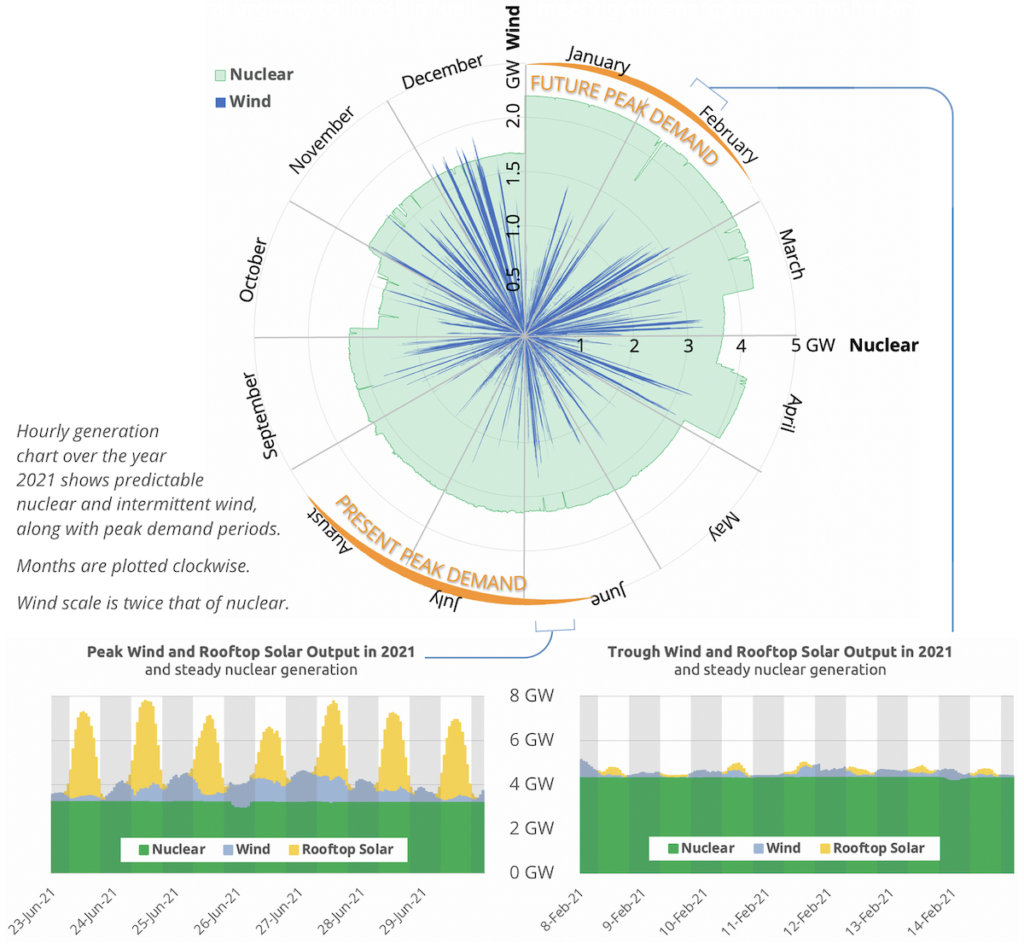
A key energy security imperative is having a robust, resilient grid — one that can keep the lights on in the face of extreme weather events or emergencies. With electrified heating, transportation, and industrial processes, the consequences of supply shortages go from economically severe to incredibly dangerous and life threatening.
The CAC Plan relies heavily on the importing and exporting electricity from and to neighboring power grids. The issue, however, is that many of these states will be experiencing the same weather as New York. Meteorologically, wind patterns are very large, sometimes spanning entire continents. This means that reliance on neighboring grids is unlikely to overcome large-scale wind lulls, as that may just result in a larger number of simultaneously idle wind turbines. Similarly, large storms will result in similar weather conditions across large geographical areas.
Intermittency of solar and wind generation is not a trivial matter. The electric grid requires absolute moment-to-moment continuity in power supply in-line with demand. During 2021, peak one-week wind and solar generation in New York was nearly 10 times the trough output. No energy storage option has the necessary technological maturity, affordability, or scalability to back up a grid for any extended period of time. Expanding battery storage to power the entire state for hours at a time would be incredibly resource-intensive and environmentally damaging. Believing that unproven technologies will overcome seasonal energy storage will ensure that New York remains hooked on fossil fuels.

The CAC Plan makes New York reliant on her neighbors for 47% of onshore wind and 39% of hydro for electricity. This plan also expects New York’s neighbors to provide half the hydrogen to power our hard-to-decarbonize sectors, and supply grid-balancing electricity when New York cannot provide for herself. Bright Future eliminates the need for all dedicated wind and electricity imports, freeing our neighbors to use their valuable resources. It also does not need to import hydrogen to keep New York’s lights on.
Community Considerations
After comprehensive analysis of sustainable energy choices, the EU’s highest scientific body deemed “There is no science-based evidence that nuclear energy does more harm to human health or to the environment than other… climate change mitigation [technologies].”
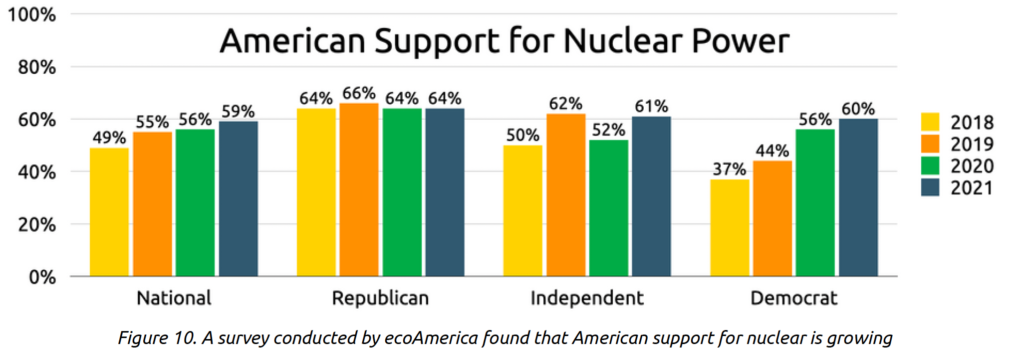
A 2021 survey by ecoAmerica, an independent non-profit building climate leadership, found that American support for nuclear power has grown from 49% in 2018 to 59% by 2021, with Democrats’ support fast catching up with that of Republicans
Conclusion
New York’s carbon-free future is bright, but only if we steward the existing clean energy we have and usher in a new era of reliable, resilient, and clean power. Bright Future brings a data-driven approach rooted in real-world case studies to improve upon the CAC Plan. Nuclear is an evidence-based pathway of deep decarbonization, one that New York has walked before. Thanks to nuclear and hydro, upstate New York already has a world-leading 90% carbon-free electric grid.
New York has the necessary expertise, nation leading apprenticeship programs, and financial sophistication to capture the economic rewards of carbon-free nuclear power. With the right technological choices and policies, New York can deploy our most scalable tool in the fight against climate change while ensuring a prosperous future.
